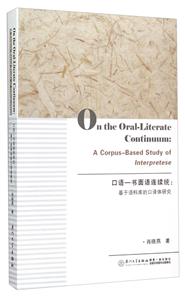
作者:赵晓临著
页数:264页
出版社:上海人民出版社
出版日期:2018
ISBN:9787208150225
电子书格式:pdf/epub/txt
内容简介
本书采用基于语料库的对比研究方法, 探讨中国学习者书面英语语料库中立场副词的语言特征。书中对中国学习者的立场副词数据与英国学生书面语的立场副词数据进行对比分析, 同时用英国伯明翰大学的英语语料库 (BoE) 以补充立场副词的语境信息。
作者简介
赵晓临,研究方向为语料库语言学、中介语对比研究、学术英语语篇研究,相关代表作发表在《外语界》、《外语研究》、《外语电话教学》、《解放军外国语学院学报》等期刊:主持了上海市浦江人才计划项目“纺织科学学术英语网络检索语料库的建设与应用”、上海市“东华大学翻译硕士研究生宁波杭州湾新区科技翻译实践基地”、中央高校基本科研业务费重点计划项目、东华大学“外国语言文学”学科重点建设项目等课题。
2008—2009年在英国伯明翰大学语料库研究中心访学,2014—2016年任肯尼亚莫伊大学首任院长。现任东华大学外语学院院长,兼任上海外文学会常务理事、上海市大学英语教学指导委员会委员。
目录
Acknowledgements
Preface
前言
Tables
Figures
Abbreviations
Introduction
1.1 Background
1.2 Objectives
1.3 Outline
2 Stance and Stance Adverbs
2.1 Notion of”stance”
2.2 Functions of stance
2.3 Previous studies on stance adverbs
2.4 Definition of “stance” in this study
2.5 The classification of stance adverbs in this study
2.6 Summary
3 Research Design
3.1 The analytical framework
3.2 The corpora to be used
3.3 The software tools to be used
3.4 Data processing
3.5 Summary
4 Frequency Distribution of Stance Adverbs in CLEC
4.1 Overall data profiles
4.2 Data of the three subcategories
4.3 Clausal position distribution
4.4 Data of major patterns
4.5 Summary
5 Patterns and Features: Certainty Epistemic Adverbs
5.1 Salient expression of high certainty
5.2 Certainty stance-taking concerning writer- and reader-mentions
5.3 Preference for the clausal-initial position
5.4 Patterns in the clausal-medial position
5.5 Summary
6 Patterns and Features: Likelihood Epistemic Adverbs
6.1 Colloquial expression of likelihood epistemic stance
6.2 Likelihood stance-taking concerning reader- and writer-mention
6.3 Clausal-initial preference and its functions
6.4 Prominence of the pattern will + Adv
6.5 Inflexibility of likelihood stance expression
6.6 Summary
7 Patterns and Features: Attitude and Style Stance Adverbs
7.1 Patterns and functions of attitude stance adverbs
7.2 Patterns of style stance adverbs and their functions
7.3 Summary
8 Conclusions and Implications
8.1 Summary of this study
8.2 Causal factors for stance expressions
8.3 Implications for EFL language pedagogy
Preface
前言
Tables
Figures
Abbreviations
Introduction
1.1 Background
1.2 Objectives
1.3 Outline
2 Stance and Stance Adverbs
2.1 Notion of”stance”
2.2 Functions of stance
2.3 Previous studies on stance adverbs
2.4 Definition of “stance” in this study
2.5 The classification of stance adverbs in this study
2.6 Summary
3 Research Design
3.1 The analytical framework
3.2 The corpora to be used
3.3 The software tools to be used
3.4 Data processing
3.5 Summary
4 Frequency Distribution of Stance Adverbs in CLEC
4.1 Overall data profiles
4.2 Data of the three subcategories
4.3 Clausal position distribution
4.4 Data of major patterns
4.5 Summary
5 Patterns and Features: Certainty Epistemic Adverbs
5.1 Salient expression of high certainty
5.2 Certainty stance-taking concerning writer- and reader-mentions
5.3 Preference for the clausal-initial position
5.4 Patterns in the clausal-medial position
5.5 Summary
6 Patterns and Features: Likelihood Epistemic Adverbs
6.1 Colloquial expression of likelihood epistemic stance
6.2 Likelihood stance-taking concerning reader- and writer-mention
6.3 Clausal-initial preference and its functions
6.4 Prominence of the pattern will + Adv
6.5 Inflexibility of likelihood stance expression
6.6 Summary
7 Patterns and Features: Attitude and Style Stance Adverbs
7.1 Patterns and functions of attitude stance adverbs
7.2 Patterns of style stance adverbs and their functions
7.3 Summary
8 Conclusions and Implications
8.1 Summary of this study
8.2 Causal factors for stance expressions
8.3 Implications for EFL language pedagogy















